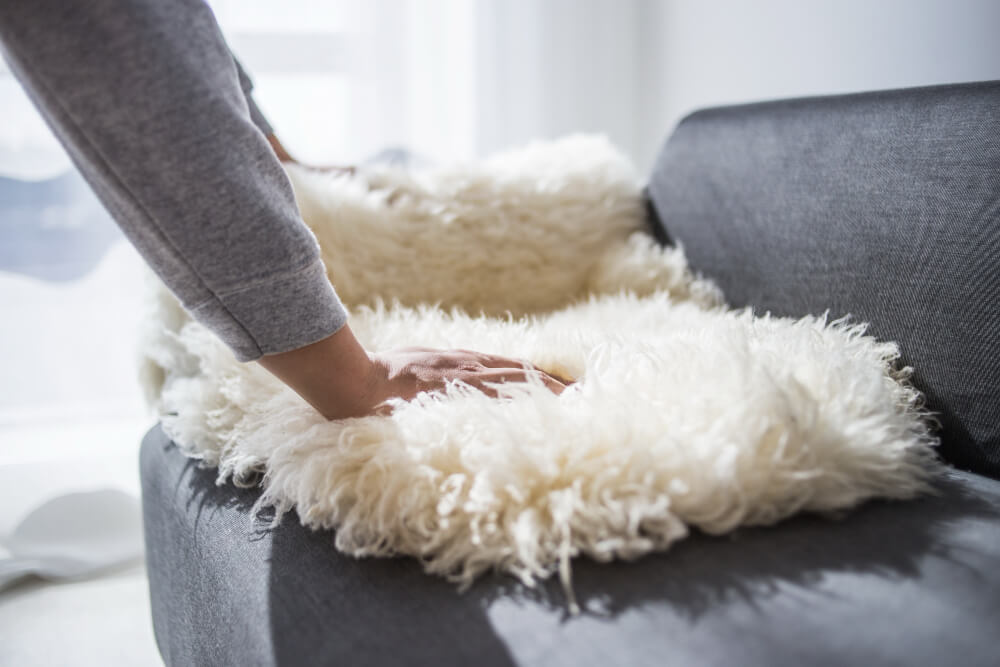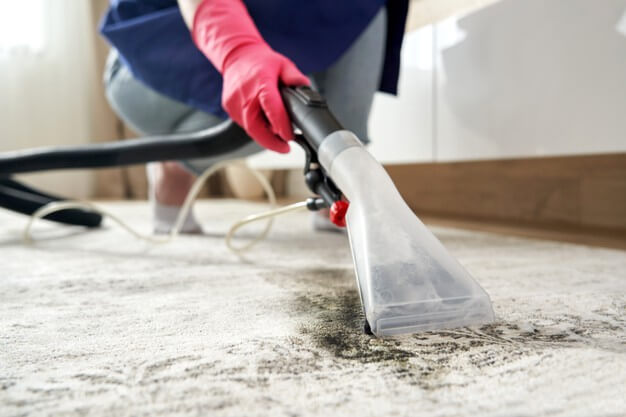





Natural fiber rugs are popular home accents due to their earthy tones and durability. A natural fiber rug can instantly make any room more relaxed as it brings in natural elements into your home. Natural fiber rugs, or natural rugs, can be found in many different sizes, styles, and designs, so you can be sure to find one that fits your aesthetic!
However, unlike acrylic and wool rugs, natural rugs offer a different texture and material. Natural rugs are also sensitive to moisture, and are challenging to clean if you’re not aware of the proper methods to do so. In this guide, we’ll present ways you can safely clean your natural rugs.
Common Types of Natural Fiber Rugs
Natural fiber is a broad term that can refer to any fiber derived from plant matter, like hemp, jute, or sisal. While most natural fibers dry in its own shade of green or brown, the material can be dyed to present more vivid colours.
- Jute - Jute fiber rugs are made with the stalk of the plant instead of the leaves, giving the rug a soft feel not too dissimilar from cotton or wool fabrics. However, the material can flatten over time, so best to place these jute fiber rugs in low to moderate traffic areas, and away from humidity.
- Hemp - Hemp fiber provides a tough, durable rug that is resistant to mold and mildew. The fibers are usually coarse, and stand up like brush bristles. Using hemp around humid areas, like the bathroom, laundry room, and the like, can give those rooms a natural feel without the high maintenance. Hemp, however, tends to shed fibers.
- Sea Grass - Sea Grass is the most water resistant material used for natural fiber rugs. Made from underwater plant matter, sea grass is soft, durable, and offers a smoother texture than those of jute and hemp. Sea Grass rugs make great additions to bathrooms, as they don’t retain water and are soft to the touch on bare feet.
- Sisal - What do sisal rugs and sugar free syrups have in common? They’re both derived from the agave plant! Sisal rugs are woven from the leaves and stems of the plant, and offer the toughest durability out of all natural fiber materials. However, sisal rugs are very absorbent, making spills and stains more difficult to clean with this material.
- Bamboo - Bamboo is actually classified as a grass, despite its woodsy texture. Bamboo is a sustainable material that provides rugs in light green to tan hues to make any room bright, yet relaxing. Bamboo is slightly water resistant and mold resistant, so they do well in humid environments. However, keep moisture away from bamboo as the material may rot when wet.

How to Clean Natural Fiber Rugs
Improper cleaning methods can damage natural rugs by pulling out the fibers, introducing moisture that can host mold, or causing the organic material to burn through heat cleaning. Remember that natural fibers come from plant matter, thus they are sensitive to most industrial cleaning solutions.
Cleaning natural fiber rugs means cleaning with minimal or no water. Since natural fibers are organic materials, water can damage them and cause them to deteriorate. Cleaning your natural fiber rug is best done dry, using dry cleaning methods and cleaning solutions that won’t damage your natural fiber rugs.
1. Shake it Off
The way natural fiber rugs are woven together gives them small pockets where dirt and dust can settle into. Shaking off a natural fiber rug loosens the grip of the dirt to the material, and flicks dust particles away from your rug.
- Take your natural fiber rug outside, or in an area you can easily sweep, and shake it out.
- Give the rug a good, strong shake until all the dirt has been removed.
- Alternatively, you may hang the rug on a clothesline and use a rug beater to shake the dirt out.
2. Dry Cleaning with Baking Soda
Baking soda makes a wonderful carpet cleaner, and it is a safe and effective alternative to powdered carpet cleaners. Baking soda can be used to dry clean and deodorize your natural fiber rugs without damaging the material.
- Sprinkle a generous amount of baking soda onto your natural fiber rugs.
- Gently brush the powder into the fibers, but avoiding harsh movements that can get the particles stuck deep into the fibers.
- Let the baking soda sit for a few minutes before shaking it out.
- Take your rug and make sure to give it a good shake.
- You may also use the vacuum cleaner to suck up excess powder.
Baking soda is also great for cleaning up liquid spills, as the powder sucks out moisture from surfaces. After a spill, wipe the liquid away from the surface of the rug. Place a spoonful of baking soda directly on top of the dampened area and allow the powder to suck up the excess liquid. Wipe clean or shake the baking soda away. Your rug should now be dry!
3. Spot Cleaning
For sudden spills, immediately blot the stain with a clean tissue, paper towel, or cloth before it sinks deeper into your rug. Make sure you blot the stain instead of rubbing it to prevent the stain from spreading onto untouched areas. If the stain does not go away, dip your cloth in some diluted soapy water, and gently dab the stain until it disappears.
- For deep-seated stains, we recommend using a commercial natural fiber rug cleaner like Sisal Rugs’ Rug Spot Cleaner. Similar commercial rug cleaners are formulated for natural fibers, so you won’t have to worry about damaging the material.
- For solid and semi-solid stains, use a dull knife to scrape away the spill. Blot the stained areas with diluted soapy water, or a commercial rug spot cleaner.
- For greasy food spills, dish soap works well to break down the grease stains.
Helpful Tip: Completely dry your natural fiber rug even after spot cleaning to prevent the growth of mold and mildew. Keeping your natural fiber rugs dry also prevents the material from rotting.
4. Vacuum Cleaning
The vacuum cleaner is a rug’s best friend, and same goes for natural fiber rugs. Using the dry function of your vacuum cleaner, suck up any loose dirt and dust from your natural fiber rug to maintain its cleanliness. The frequency of cleaning will depend on where you place your rug. Clean more often in high traffic areas, less in low traffic areas.
The vacuum cleaner can be used with a commercial carpet cleaning powder to refresh your natural fiber rugs, as well as remove deep-seated dirt hidden in the natural fibers. Make sure to remove the beater bar before you use your vacuum cleaner to avoid scuffing up the rug material.
Keeping Your Natural Fiber Rugs Clean
Going beyond cleaning your natural fiber rugs when they get grime, you will need to know how to properly care and maintain your rugs so you will not have to worry about removing stains too often. Here are a few tips on caring for your natural rugs:
- Vacuum the rugs daily to remove any dirt before they settle into the fibers of your rug.
- Jute and other natural fibers tend to curl up over time due to pressure and regular use. Flatten down the rug by dampening the curled area with water, covering it with a thick cloth or towel, and using an iron on the lowest heat setting to flatten the rug.
- Keep your natural rugs dry as natural rugs tend to mold or rot when exposed to constant moisture.
- Use a fabric protector spray or wax to coat your natural rug in a protective layer that prevents moisture or oils from seeping into the fibers. You may even use a DIY version made from beeswax or soy wax.
DIY Wax made from Beeswax or Soy Wax:
- Melt your beeswax or soy wax over a double boiler or in the microwave until the particles are fully melted.
- Let the wax cool just until warm.
- Use a soft cloth that you can throw away afterwards to wipe the melted beeswax or soy wax onto your natural rug, getting into the fibers and pockets. Make sure to apply a thin, even layer of wax.
- Grab a heat gun on the lowest setting, or a hair dryer, and use it to melt the wax into your rug so the wax can seep deep into the fibers.
- Let the wax cool and you’ve got a water and stain proof rug!
Find Professional Cleaning Services
Nervous about cleaning your natural fiber rugs? Why not give your home some care with professional carpet cleaning services? Professional cleaners will not only clean your natural fiber rugs, but they can also clean every inch of your home so you can keep living dust-free!
We at Luce SG are thrilled to give our customers the best possible cleaning service we can offer. Our expert cleaners are experienced in cleaning all types of homes and materials, so you can trust that we’ll get the job done right! Contact us today and we can book you a schedule that works for you.




















